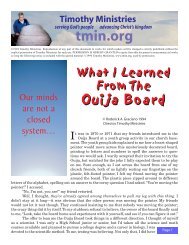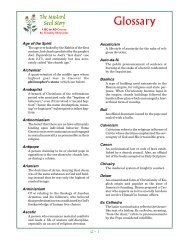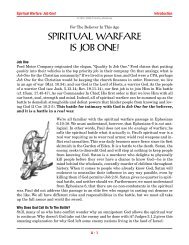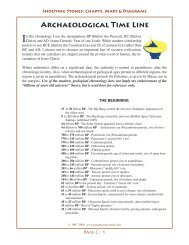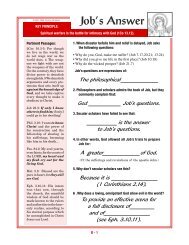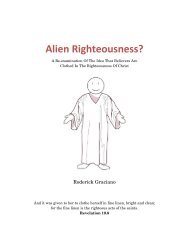Making The Invisible Visible Section 4
Making The Invisible Visible Section 4
Making The Invisible Visible Section 4
Create successful ePaper yourself
Turn your PDF publications into a flip-book with our unique Google optimized e-Paper software.
Hermeneutics: <strong>Making</strong> <strong>The</strong> <strong>Invisible</strong> <strong>Visible</strong> — © 2004 Roderick Graciano<br />
<strong>The</strong> Data<br />
Hebraic thought and language is known for its emphasis upon the active function and inherent character of<br />
things, its vividness of metaphor and symbol, and its holistic perspective of events and their chronology. While<br />
any one of these attributes of Hebrew may not be unique among Semitic tongues, the bundling of all these<br />
attributes together into one language provides a unique approach to communication — one that is significantly<br />
different from the way we communicate in the west.<br />
<strong>The</strong> <strong>The</strong>ory<br />
I propose that the unique combination of attributes attached to Hebraic thought and language developed under the<br />
guidance of Godʼs providence for the unique purpose of communicating about invisible spiritual realities.<br />
<strong>The</strong> media accommodates our society and it has spoiled us. <strong>The</strong>refore, as Americans,<br />
we tend to read the Holy Bible as though it also were scripted for our<br />
western culture and ready for our easy assimilation. As a result, we miss the<br />
subtle nuances and connotations of the biblical text that were obvious to the Bible’s<br />
original Semitic authors and audience. Sometimes, we misinterpret words and phrases<br />
that meant something entirely different in Middle Eastern antiquity than they do in<br />
our time and place. It behooves us, then, to learn what we can, not only about ancient<br />
Israelite culture in general, but also about Hebraic thought patterns in particular, since<br />
they — not Hellenistic or other western modes of thought — constitute the framework<br />
that supports and gives shape to the biblical text. As John Dillenberger has said with<br />
regard to the biblical revelation, “to ignore Hebraic ways of thinking is to subvert<br />
Christian understanding.” 1<br />
Spiritual Realities In Human Language<br />
I believe that one observation, above all others, will help us understand the distinctives<br />
of the Hebrew language and of the Hebraic thought patterns that undergird even<br />
the New Testament text. That one observation is that God uniquely called Israel as<br />
the vehicle of His revelation to the other nations of the world. God gave the Hebrews<br />
the task of proclaiming spiritual realities in human language. I don’t suggest that<br />
the Israelites consciously shaped their language for this divine purpose, nor that the<br />
individual traits of their language are unique to Hebrew. However, it appears to me<br />
that the nature of Israel’s calling inevitably, if unconsciously, shaped the combined<br />
distinctives of her thought and expression, so that the Hebrews learned to:<br />
Page 2





